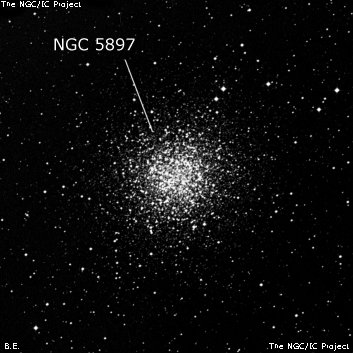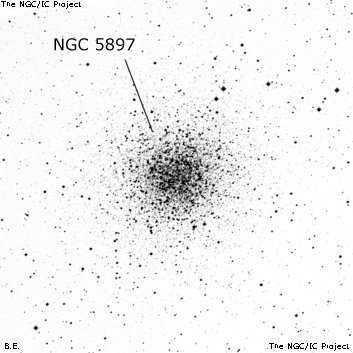NGC/IC Project Restoration Effort
(This is a very very beta version)
NGC5897


Basic Information
Location and Magnitude
Right Ascension: 15:17:24.5
Declination: -21:0:35
Constellation: LIB
Visual Magnitude: 8.4
Historic Information
Discoverer: Herschel W.
Year of discovery: 1785
Discovery aperture: 18.7
Observational
Summary description: globular, pF, L, viR, vgbM, rrr
Sub-type: XI
Corwin's Notes
=====
NGC 5897 is H VI 8 as well as H VI 19. JH noted the identification problem
with the stars observed in WH's Sweep 209 on 25 April 1784 (see CGH, p. 109),
and Auwers and Dreyer have notes about the field [Dreyer's are in the NGC, p.
223; IC1, p. 284 (combined NGC/IC edition of 1962); WH's Scientific Papers,
Volume 1, p. 302; and MNRAS 73, 37, 1912]. (Marth apparently also published a
note on VI 8 in 1864, but I have not seen that.) None of these folks
positively identified VI 8, the only non-stellar object seen in the sweep,
though Dreyer mentioned the possibility of N5897 and was leaning toward N5634
in 1912.
The confusion arose simply because 25 April was a poor night; WH noted "flying
clouds and hazy" at the beginning of the sweep. Nevertheless he, hoping to
see more of the great "stratum" of nebulae that he'd found the previous
months, swept for just over half an hour until he was completely clouded out.
The entire sweep consists of four stars and one cluster. Dreyer reproduces
the sweep in the Scientific Papers:
13h 57m .. .. flying clouds and hazy
14 01}
} 62 1d19' 7.8m
-0.5}
10.7 89 1 45 7m
12.5 0 19 cluster ...
25.2 59 1 16 star
25.4 -16 4 6.7m
31 .. .. cloudy
The first column is the clock reading. Dreyer notes that WH reset the clock
after the previous sweep, and that there is an uncertainty of 11 or 12 minutes
in the readings. The second column is not explained, but is apparently a raw
reading, approximately in arcminutes, of the relative north polar distance.
The third column is reduced to relative north polar distance in degrees and
arcminutes, and the fourth gives notes and object descriptions. So, the sweep
consists of relative positions of four stars and one cluster.
WH's full description of the cluster clearly makes it a globular: "A very
close, compressed cluster of stars, 8 or 9' in diameter, extremely rich, of an
irregular round figure, a little extended. The stars are so small as hardly
to be visible, and so accumulated in the middle as to look nebulous."
There are only three globular clusters in the right RA (14h to 16h) and Dec
(+5d to -25d) ranges: NGC 5634, NGC 5897, and NGC 5904 (M 5). None of the
historical sources mention NGC 5904, probably assuming it is too large and
bright to have been WH's mystery object. As I've noted, Dreyer seemed to
favor N5634 over N5897. However, N5634 is only half the size noted by WH, and
has a bright star near to the southeast, and another even brighter star fairly
close to the south-southwest. WH would have noted these in any description
that he made of the object (as he, in fact, did; see the GC and NGC
descriptions for N5634).
This leaves NGC 5897 as the most likely candidate. That it is indeed the
correct object can be shown by reducing the relative clock times and polar
distances for the stars to absolute values, using the equinox 1784.32 position
of the cluster as the origin. That gives the following positions for
equinoxes 1784.32 and (precessed to) J2000:
RA (1784.32) Dec RA (J2000) Dec RA (Ty2) Dec V BD
14 53.6 -21 12 15 06.0 -22 03 15 06 27.14 -22 01 54.6 6.14 -21 4030
15 03.2 -21 38 15 15.7 -22 27 15 16 23.01 -22 23 57.9 5.52 -21 4065
15 17.7 -21 09 15 30.2 -21 54 15 30 42.81 -21 52 42.8 7.80 -21 4128
15 17.9 -19 57 15 30.3 -20 42 15 30 36.25 -20 43 42.8 6.21 -20 4246
I've added the Tycho-2 positions, the V magnitudes, and the BD identifications
to the table. It's easy to see that WH's positions are systematically too
small in RA and too far south in Dec. But if the systematic differences are
removed, the stars match the modern positions to within WH's usual errors (3-4
arcmin). It's also easy to see the effect of the clouds on WH's magnitude
estimates, too.
Going through the exercise using NGC 5634 and M 5 as the origins shows that
they could not have been WH's cluster -- there are no stars near them matching
the relative positions and magnitudes noted in the sweep.
Dreyer could have performed this same exercise with the BD (I used SAO and the
version of Tycho-2 online at CDS), but for some reason did not. Since it is
an obvious check, and could easily have been done using the BD data, I wonder
if anyone else has thought to do this over the years.
In any event, there is no doubt that NGC 5897 is the mystery object H VI 8.
Steve's Notes
=====
NGC 5897
18" (7/11/07): this low surface brightness globular was easily picked up 12.5x in the 80mm finder as a small, faint, hazy knot. Excellent view at 225x in the 18" with 60-70 stars resolved and a very weak concentration and no distinct core. At 325x, 90-100 stars were resolved over an 11' diameter though the halo does not have a well defined edge so the count is somewhat arbitrary. The hazy background glow of unresolved star is quite lively and irregular in surface brightness.
17.5" (6/3/00): large, loose, globular, ~10' in diameter with only a weak concentration and no core. At 280x, 60-70 stars are resolved in good moments of seeing and many appear to be arranged in strings (two on the east side of the halo) emanating from the central region. The extent of the halo is ill-defined.
17.5" (6/6/86): this is a low surface brightness globular of 10' diameter with little concentration. Roughly circular although the outline is irregular. Well resolved into 50 stars at 286x over haze although NGC 5897 is too large for a good view at high power. About 5' NNE of center is a string of three mag 11.5, 12 and 14 stars with a total length of 1.4'.
13.1" (6/30/84): about two dozen faint stars resolved over irregular haze.
13.1" (6/19/82): a number of faint stars resolved over a larger region of haze.
12x80 (6/30/84): very faint but visible in the finder!



